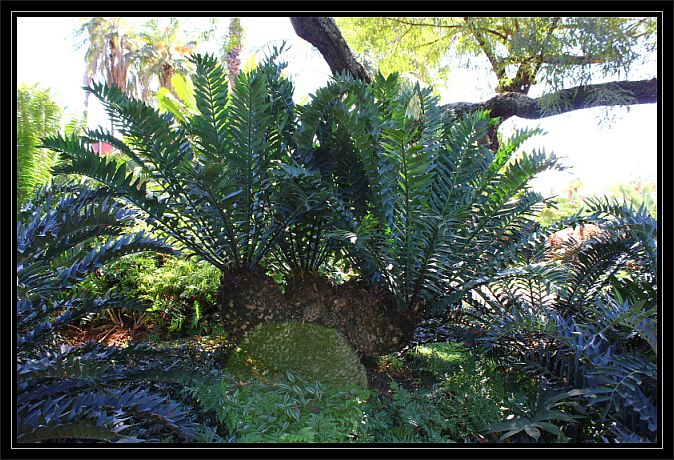E.arenarius
This cycad species is endemic to South Africa. These plants grow in a small, limited area near Alexandria in the Eastern Cape Province, where they grow on stabilized sand dunes. These plants will do well in full sun or semi shade. There is also a very rare "blue" form that is virtually extinct in nature, that should be grown in full sun.

"E.arenarius stems may be up to 1m tall, but in its habitat the lower part of the stem is usually covered by sand and leaf mold. Smaller plants often appear to have subterranean stems for this reason. The diameter of the stem is 20cm to 30cm but it may be wider at the base. The crown of the stem is covered with light-brown hair, especially before new leaves are formed. Single stems occur, but plants are more usually branched from the base to form clumps with stems of varying height. Taller stems usually lean over to one side.
The attractive leaves of E.arenarius may be 1m to 1.5m long, including a leaf stalk of 15cm to 20cm long. The rachis is recurved at the tip and the leaves are light green when they are young with a slight bloom. Older leaves become darker green in colour and the bloom disappears. In a few, probably dryer, localities a bluish-green form occurs.

The pinnae at the middle of the leaf are 12cm to 16cm long and 2,5cm to 4cm broad. The leaflets have three or four lobes on the lower margin. The upper margin is usually smooth, but may occasionally have one tooth. The lobes are in the same plane as the leaflet or slightly twisted. The lower leaflets have only one or two lobes and are reduced in size to an occasional single prickle. Seedling leaves have three lobes at the tip, with or without a tooth on the upper margin and one or two teeth or lobes or the lower margin. The leaflets overlap in the top part where they are attached to the rachis in the form of a "V". Lower down they are more widely spaced and more spreading.

Single cones are formed. Mature cones are light green in colour and are borne on a short thick peduncle, 4cm to 8cm long. The male cone is 30cm to 50cm long and 8cm to 15cm in diameter. The scales at the middle of the cone are approximately 3.5cm long and 2.5cm wide. The beak of the scale protrudes approximately 1cm.
Male cone

The female cone is barrel-shaped, 35cm to 60cm long and 20cm to 30cm in diameter. The scales at the middle of the cone are approximately 7cm long, 5cm broad and 4cm high. The face of the scale is usually four-sided with a slightly wrinkled surface and a beak which protrudes approximately 2cm. The female cone is often pushed down to an almost horizontal position by the formation of new leaves. The sarcotesta is red and shiny and seeds are approximately 5cm long and 2,5cm wide, with a fleshy beak.
Female cone

E.arenarius was once fairly numerous in its habitat area. It was threatened even before it was described as a species, however. When Dr Dyer visited the area in 1954, he was told by local farmers that "a large number had been removed for cultivation within recent times". (Dyer, R.A. : "A new cycad from the Cape Province".) Numerous plants were also removed to make way for farming activities, especially the establishment of pastures for dairy herds.
The accessibility of the habitat and the relative ease with which plants can be removed from the sandy soil, have made E.arenarius an easy target for destructive collectors. Truckloads of plants were illegally removed with the result that E.arenarius has now become fairly rare in nature."
@ Lisbeth - this one is easy to recognise. It has blue leaves if it is grown in full sun and green leaves if grown in the shade, though you can't really notice the blueish colour in the photos.





